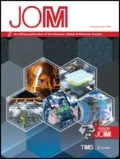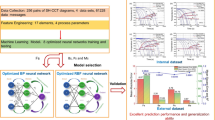Abstract
Continuous cooling transformation diagrams in synthetic weld heat-affected zones (SH-CCT diagrams) are important tools to analyze the microstructure and mechanical properties of the heat-affected zone under certain welding conditions and to evaluate the weldability of steel. In this study, various machine-learning approaches are used to select an appropriate model for prediction of SH-CCT diagrams for Ni-Cr-Mo steels using relevant material descriptors including the chemical compositions and cooling rate. Random forest is the best model to predict the ferrite and bainite transition start temperature accurately, K-nearest neighbors is suitable for predicting the start temperature of martensite transformation, and random committee is used to predict the hardness. These optimal models are used to predict the SH-CCT diagrams of five kinds of steels to verify the accuracy. The results show that the predicted values of the optimal models agree well with the experimental data with a strong correlation coefficient and low error value.







Similar content being viewed by others
References
D.F. Watt, L. Coon, M. Bibby, J. Goldak, and C. Henwood, Acta Metall. 36, 3029–3035 (1988).
H. Sekiguchi and M. Inagaki, Trans. NRIM. 2, 102–125 (1960).
Y. Liu, L.Q. Yang, B. Feng, S.W. Bai, and C.X. Xu, Mater. Sci. Forum 762, 556–561 (2013).
P.L. Harrison and R.A. Farrar, Int. Mater. Rev. 34, 35–51 (1989).
G. Krauss, Principle of heat treatment of steels, 1st ed. (Ohio: American Society for Metals, 1980), pp. 97–101.
J. Górka, IJEMS. 22, 497–502 (2015).
M. Xiangxu, M. Yonglin, X. Shuqing, C. Zhongyi, H. Na, and B. Qingwei, Heat Treat. Met. 40, 59–63 (2015).
J. Sun, Z. Li, Y. Jiang, D. Li, K Zhang. Mater. Mech. Eng. 33(01), 17–19+39 (2009).
A. Pohjonen, M. Somani, and D. Porter, Comput. Mater. Sci. 150, 244–251 (2018).
J. Trzaska, A. Jagieo, and L.A. Dobrzanski, Arch. Mater. Sci. Eng. 39, 13–20 (2009).
M. Drosback, JOM. New York 66, 334–335 (2014).
G.J. Schmitz and U. Prahl, Integrative Computational Materials Engineering: Concepts and Applications of a Modular Simulation Platform, 1st ed. (Hoboken: Wiley, 2012).
S. Chakraborty, P.P. Chattopadhyay, S.K. Ghosh, and S. Datta, Appl. Soft Comput. 58, 297–306 (2017).
W.G. Vermulen, S. Van Der Zwaag, P. Morris, and T. Weijer, Steel Res. 68, 72–79 (1997).
J. Wang, P.J. Van Der Wolk, and S. Van Der Zwaag, ISIJ Int. 39, 1038–1046 (1999).
J. Trzaska, Arch. Mater. Sci. Eng. 82, 62–69 (2016).
S. Chakraborty, P. Das, N.K. Kaveti, P.P. Chattopadhyay, and S. Datta, Multidiscip. Model. Mater. Struct. 15, 170–186 (2019).
“MatNavi, National Institute for Materials Science Materials Database”, https://mits.nims.go.jp/index_en.html. Accessed 23 July 2019.
S. Moeinifar, A.H. Kokabi, and H.R. Madaah Hosseini, J. Mater. Process. Technol. 211, 368–375 (2011).
J.M. Keller, M.R. Gray, and J.A. Givens, IEEE Trans. Syst. Man Cybern. 4, 580–585 (1985).
H.S. Seung, M. Opper, H. Sompolinsky, in Query by committee, Proceedings 5th Annual Workshop on Computational Learning Theory, 1st ed. (ACM Press, New York, 1992) p. 287–294
S.C. Chelgani, S.S. Matin, and S. Makaremi, Measurement 94, 416–422 (2016).
M.W. Gardner and S.R. Dorling, Atmos. Environ. 32, 2627–2636 (1998).
G.C. Cawley and N.L.C. Talbot, J. Mach. Learn. Res. 11, 2079–2107 (2010).
B. Efron, J. Am. Stat. Assoc. 78, 316–330 (1983).
R. Kohavi, IJCAI. 95, 1137–1145 (1995).
J.J. Filliben, Technometrics 17, 111–117 (1975).
J.R. Taylor, An introduction to error analysis: the study of uncertainties in physical measurements, 2nd ed. (Sausalito: University Science Books, 1997), p. 217.
T. Chai and R.R. Draxler, Geosci. Model Dev. 7, 1247–1250 (2014).
X. Jiang, H.Q. Yin, C. Zhang, R.J. Zhang, K.Q. Zhang, H.D. Zheng, G.Q. Liu, and X.H. Qu, Comput. Mater. Sci. 143, 295–300 (2018).
Acknowledgements
The authors acknowledge the financial support from the National Key Research and Development Program of China (No. 2017YFB0903901), the National Natural Science Foundation of China (No. 51571020), the Fundamental Research Funds for the Central Universities (Project No. FRF-IC-19-003), the State Key Laboratory for Advanced Metals and Materials (No. 2019Z-6) and the Fundamental Research Funds for the Liaoning Universities (LJ2017QL006).
Author information
Authors and Affiliations
Corresponding author
Additional information
Publisher's Note
Springer Nature remains neutral with regard to jurisdictional claims in published maps and institutional affiliations.
Electronic supplementary material
Below is the link to the electronic supplementary material.
Rights and permissions
About this article
Cite this article
Geng, X., Wang, H., Ullah, A. et al. Prediction of Continuous Cooling Transformation Diagrams for Ni-Cr-Mo Welding Steels via Machine Learning Approaches. JOM 72, 3926–3934 (2020). https://doi.org/10.1007/s11837-020-04057-z
Received:
Accepted:
Published:
Issue Date:
DOI: https://doi.org/10.1007/s11837-020-04057-z




